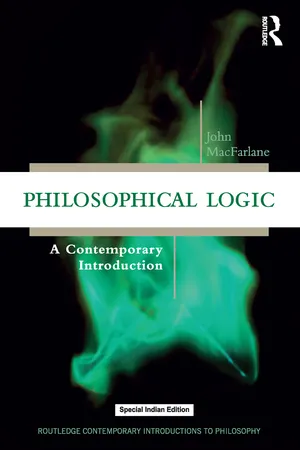
- 238 pages
- English
- ePUB (mobile friendly)
- Available on iOS & Android
About this book
Introductory logic is generally taught as a straightforward technical discipline. In this book, John MacFarlane helps the reader think about the limitations of, presuppositions of, and alternatives to classical first-order predicate logic, making this an ideal introduction to philosophical logic for any student who already has completed an introductory logic course.
The book explores the following questions. Are there quantificational idioms that cannot be expressed with the familiar universal and existential quantifiers? How can logic be extended to capture modal notions like necessity and obligation? Does the material conditional adequately capture the meaning of 'if'—and if not, what are the alternatives? Should logical consequence be understood in terms of models or in terms of proofs? Can one intelligibly question the validity of basic logical principles like Modus Ponens or Double Negation Elimination? Is the fact that classical logic validates the inference from a contradiction to anything a flaw, and if so, how can logic be modified to repair it? How, exactly, is logic related to reasoning? Must classical logic be revised in order to be applied to vague language, and if so how? Each chapter is organized around suggested readings and includes exercises designed to deepen the reader's understanding.
Key Features:
- An integrated treatment of the technical and philosophical issues comprising philosophical logic
- Designed to serve students taking only one course in logic beyond the introductory level
- Provides tools and concepts necessary to understand work in many areas of analytic philosophy
- Includes exercises, suggested readings, and suggestions for further exploration in each chapter
Frequently asked questions
- Essential is ideal for learners and professionals who enjoy exploring a wide range of subjects. Access the Essential Library with 800,000+ trusted titles and best-sellers across business, personal growth, and the humanities. Includes unlimited reading time and Standard Read Aloud voice.
- Complete: Perfect for advanced learners and researchers needing full, unrestricted access. Unlock 1.4M+ books across hundreds of subjects, including academic and specialized titles. The Complete Plan also includes advanced features like Premium Read Aloud and Research Assistant.
Please note we cannot support devices running on iOS 13 and Android 7 or earlier. Learn more about using the app.
Information
1.1 Propositional logic
1.1.1 Grammar


1.1.2 Semantics
Table of contents
- Cover
- Half Title
- Title Page
- Copyright Page
- Table of Contents
- List of Exercises
- Preface
- Acknowledgements
- 1 Fundamentals
- 2 Quantifiers
- 3 Modal Logic
- 4 Conditionals
- 5 Logical Consequence via Models
- 6 Logical Consequence via Proofs
- 7 Relevance, Logic, and Reasoning
- 8 Vagueness and the Sorites Paradox
- Appendix A Greek Letters
- Appendix B Set-Theoretic Notation
- Appendix C Proving Unrepresentability
- References
- Index